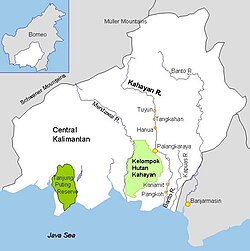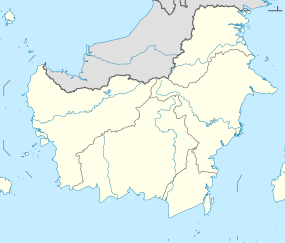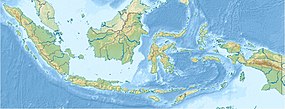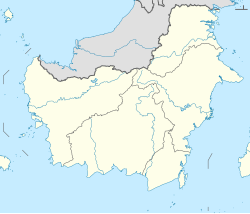| Barito River Sungai Barito, Sungai Dusun, Soengai Doesoen, Sungi Banjer, Sungi Dunsun, Soengai Baritoe, Sungai Banjar, Sungai Banjarmasin, Sungai Banjar Besar | |
|---|---|
 Barito and other rivers in Central and South Kalimantan | |
| Location | |
| Country | Indonesia |
| Physical characteristics | |
| Source | Murung River |
| • location | Müller Mountain Range |
| Mouth | |
• location | Java Sea |
• coordinates | 3°30′55″S 114°29′28″E / 3.51528°S 114.49111°E |
• elevation | 0 m (0 ft) |
| Length | Barito–Murung 1,090 km (680 mi)[1] |
| Basin size | 81,675 km2 (31,535 sq mi)[1] |
| Width | |
| • average | 250–400 m (820–1,310 ft)[2] |
| Depth | |
| • average | 8–18 m (26–59 ft)[2] |
| Discharge | |
| • location | Barito Delta |
| • average | 4,514 m3/s (159,400 cu ft/s)[3] |
| Basin features | |
| Progression | Java Sea |
| River system | Barito River[4] |
| Tributaries | |
| • left | Murung, Lampuya, Babuat, Laung, Lahei, Montallat, Tapen, Ajuh, Karau, Napu, Paminggir, Negara, Martapura |
| • right | Joloi, Bakanon, Lemu, Muning, Mangkatip, Kapuas[5] |
Barito River in Kalimantan

The Barito River is the second longest river in Borneo after the Kapuas River with a total length of 1,090 km (680 mi) and a drainage basin of over 80,000 km2 (31,000 sq mi) in South Kalimantan, Indonesia. It originates in the Müller Mountain Range, from where it flows southward into the Java Sea. Its most important affluent is the Negara and Martapura, and it passes through the city of Banjarmasin.[6][7]
This river is the location of the closest relative of the Malagasy language of Madagascar, the Ma'anyan language of Dayaks, from where settlers arrived in Madagascar (presumably in waves) from the 3rd to 10th century and from which the current island nation's population largely traces its origins.
- ^ a b Strategi & Kebijakan Pengelolaan Wilayah Sungai Barito - Kapuas dalam Rangka Mendukung Pengembangan Kawasan Perkotaan yang Berkelanjutan (Slide deck) (in Indonesian) – via Scribd.
- ^ a b "Kalamanthana".
- ^ Ting-Hsuan, Huang; Chen-Tung, Arthur Chen; Hsiao-Chun, Tseng; Jiann-Yuh, Lou; Shu Lun, Wang; Liyang, Yang; Selvaraj, Kandasamy; Xuelu, Gao; Jough-Tai, Wang; Edvin, Aldrian; G.S., Jacinto; Gusti Z., Anshari; Penjai, Sompongchaiyakul; B.J., Wang (May 2017). "Riverine carbon fluxes to the South China Sea: Riverine carbon fluxes to the SCS". Journal of Geophysical Research: Biogeosciences. 122 (5): 1239–1259. doi:10.1002/2016JG003701. S2CID 135024272.
- ^ Hukum Online. "Keputusan Menteri Kehutanan No. SK.511/MENHUT-V/2011" (in Indonesian).
- ^ M. K. Adamy (2 April 2012). "Sungai Barito Potensi Alam yang Diabaikan". Pemerintah Provinsi Kalimantan Tengah (in Indonesian). Archived from the original on 16 May 2017. Retrieved 8 January 2019.
- ^ "Annette Delarbre". Tijdschrift voor Nederlandsch Indië (in Dutch). Vol. 1. Ter Lands-drukkerij. 1838. p. 6.
- ^ Buddingh, Steven Adriaan (1861). Neêrlands-Oost-Indië: Reizen over Java, Madura, Makasser, Saleijer, Bima, Menado, Sangier-eilanden, Talau-eilanden, Ternate, Batjan, Gilolo en omliggende eilanden, Banda-eilanden, Amboina, Haroekoe, Saparoea, Noussalaut, Zuidkust van Ceram, Boeroe, Boano, Banka, Palembang, Riouw, Benkoelen, Sumatra's West-Kust, Floris, Timor, Rotty, Borneo's West-Kust, en Borneo's Zuid- en Oost-Kust; gedaan gedurende het tijdvak van 1852-1857 (in Dutch). M. Wijt. pp. 442.
de groote Banjersche rivier (de Barito).


